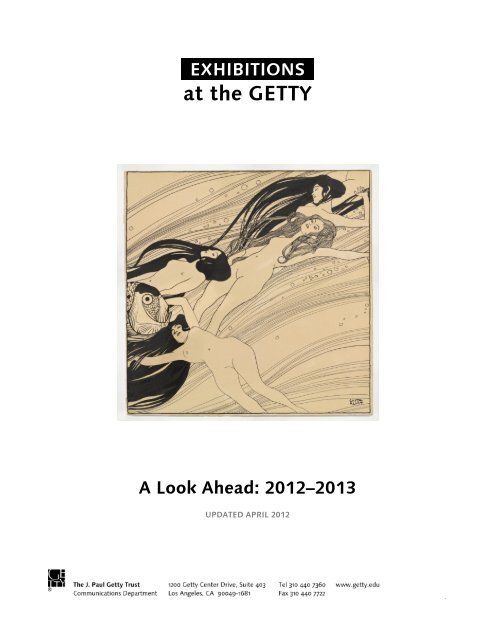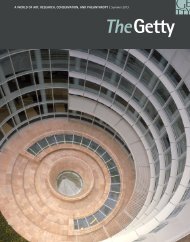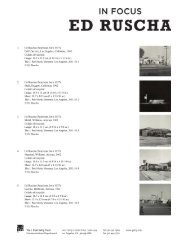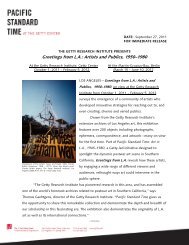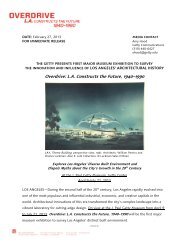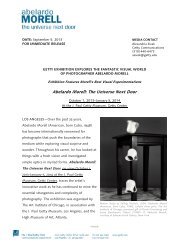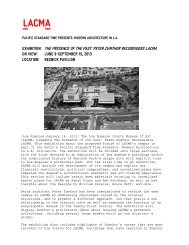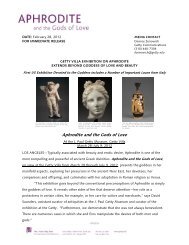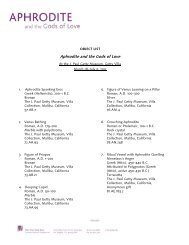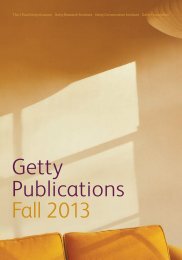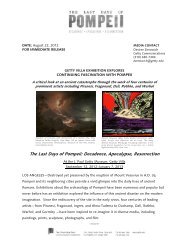Exhibitions at The GETTY - News from the Getty
Exhibitions at The GETTY - News from the Getty
Exhibitions at The GETTY - News from the Getty
You also want an ePaper? Increase the reach of your titles
YUMPU automatically turns print PDFs into web optimized ePapers that Google loves.
_EXHIBITIONS_<br />
<strong>at</strong> <strong>the</strong> <strong>GETTY</strong><br />
A Look Ahead: 2012–2013<br />
UPDATED APRIL 2012<br />
1/17
COVER IMAGE: Fishblood, 1898. Gustav Klimt (Austrian, 1862‐1918). India ink and pen on brown paper. Priv<strong>at</strong>e collection, courtesy Galerie St. Etienne, New York.<br />
Fe<strong>at</strong>ured in: Gustav Klimt: <strong>The</strong> Magic of Line (July 3–September 23, 2012)<br />
EDITORS:<br />
This inform<strong>at</strong>ion is subject to change. Please call or email for confirm<strong>at</strong>ion before publishing or<br />
check news.getty.edu for upd<strong>at</strong>es.<br />
<strong>The</strong> <strong>Getty</strong> offers a wide range of public programs th<strong>at</strong> complement <strong>the</strong>se exhibitions. For a list of<br />
rel<strong>at</strong>ed events, please check <strong>the</strong> <strong>Getty</strong> Web site calendar or subscribe to e-<strong>Getty</strong> <strong>at</strong><br />
www.getty.edu/subscribe to receive free monthly highlights via e-mail.<br />
Images and press m<strong>at</strong>erials for exhibitions will post as <strong>the</strong>y become available, or may be requested.<br />
MEDIA CONTACTS:<br />
<strong>Getty</strong> Communic<strong>at</strong>ions | 310.440.7360 | gettycommunic<strong>at</strong>ions@getty.edu | news.getty.edu<br />
Julie Jaskol, Assistant Director, Media Rel<strong>at</strong>ions | 310.440.7607 | jjaskol@getty.edu<br />
Melissa Abraham, Senior Communic<strong>at</strong>ions Specialist | 310.440.6861 | mabraham@getty.edu<br />
Desiree Zenowich, Senior Communic<strong>at</strong>ions Specialist | 310.440.7304 | dzenowich@getty.edu<br />
Amy Hood, Senior Communic<strong>at</strong>ions Specialist | 310.440.6427 | ahood@getty.edu<br />
Alexandria Sivak, Associ<strong>at</strong>e Communic<strong>at</strong>ions Specialist | 310.440.6473 | asivak@getty.edu<br />
2/17
<strong>Exhibitions</strong> <strong>at</strong> <strong>The</strong> <strong>GETTY</strong> [UPDATED APRIL 2012]<br />
Gothic Grandeur: Manuscript Illumin<strong>at</strong>ion, 1200–1350<br />
December 13, 2011–May 13, 2012<br />
Initial D: Saint Jerome with Scenes of <strong>the</strong> Life of<br />
Christ (detail view), about 1250–1262. Unknown<br />
illumin<strong>at</strong>or. Bologna (probably), Italy. Tempera and<br />
gold leaf on parchment. <strong>The</strong> J. Paul <strong>Getty</strong> Museum,<br />
Los Angeles, Ms. 107, Fol. 3v.<br />
<strong>The</strong> word "Gothic" evokes visions of soaring spires, graceful flying<br />
buttresses, and sparkling stained glass. <strong>The</strong> term is also applied to<br />
<strong>the</strong> style of manuscript illumin<strong>at</strong>ion th<strong>at</strong> reigned in Europe <strong>from</strong><br />
around 1200 to 1350. <strong>The</strong> Gothic illumin<strong>at</strong>ed manuscripts in this<br />
exhibition, drawn <strong>from</strong> <strong>the</strong> <strong>Getty</strong> Museum's collections, are<br />
characterized by whimsical marginal decor<strong>at</strong>ions, vivid narr<strong>at</strong>ives,<br />
and a n<strong>at</strong>uralistic style of painting. <strong>The</strong> period also saw an<br />
explosion in <strong>the</strong> variety of illustr<strong>at</strong>ed books being produced,<br />
ranging <strong>from</strong> scholastic university tre<strong>at</strong>ises to entertaining<br />
romances. On February 27, <strong>the</strong> pages of <strong>the</strong> manuscripts will be<br />
turned to allow visitors to see additional treasures.<br />
J. Paul <strong>Getty</strong> Museum<br />
<strong>at</strong> <strong>the</strong> <strong>Getty</strong> Center<br />
Media Contact<br />
Alexandria Sivak<br />
310.440.6473<br />
asivak@getty.edu<br />
<strong>The</strong> Life of Art: Context, Collecting, and Display<br />
February 7, 2012–Ongoing<br />
<strong>The</strong> Life of Art <strong>at</strong> <strong>the</strong> <strong>Getty</strong> Center (gallery view). In<br />
foreground: Fountain, Jean Le Roy, 1661-63. At<br />
center: Side Chair, French, about 1735-40 (modern<br />
upholstery). <strong>The</strong> J. Paul <strong>Getty</strong> Museum, Los Angeles.<br />
From <strong>the</strong> time an object is made until <strong>the</strong> day it enters a museum's<br />
collection, it may be displayed, used, and perceived in different<br />
ways. <strong>The</strong> Life of Art takes selected objects <strong>from</strong> <strong>the</strong> <strong>Getty</strong><br />
Museum's galleries and encourages visitors to sit down and spend<br />
time with <strong>the</strong>m, offering <strong>the</strong> opportunity to examine <strong>the</strong>m closely<br />
to understand how <strong>the</strong>y were made and functioned, why <strong>the</strong>y were<br />
collected, and how <strong>the</strong>y have been displayed. Through careful<br />
looking, wh<strong>at</strong> may be learned about <strong>the</strong> maker and previous<br />
owners of a French gilt-bronze wall light, for example, or <strong>the</strong><br />
transform<strong>at</strong>ion in England of a Chinese porcelain bowl? Close<br />
engagement reveals <strong>the</strong> full lives of <strong>the</strong>se works and why <strong>the</strong>y<br />
continue to be collected and cherished today.<br />
J. Paul <strong>Getty</strong> Museum<br />
<strong>at</strong> <strong>the</strong> <strong>Getty</strong> Center<br />
Media Contact<br />
Amy Hood<br />
310.440.6427<br />
ahood@getty.edu<br />
3/17
Renaissance Drawings <strong>from</strong> Germany<br />
and Switzerland, 1470–1600<br />
March 27–June 17, 2012<br />
Dancing Peasant Couple, 1525. Urs Graf (Swiss, about<br />
1485‐1527). Pen and gray and black ink; pricked for<br />
transfer (recto); Rubbed with black chalk (verso). <strong>The</strong><br />
J. Paul <strong>Getty</strong> Museum, Los Angeles.<br />
<strong>The</strong> period of 1480–1660 represents one of <strong>the</strong> high points in<br />
German art, spanning <strong>the</strong> careers of artists such as Martin<br />
Schongauer, Albrecht Dürer, Lucas Cranach <strong>the</strong> Elder, and Hans<br />
Holbein <strong>the</strong> Younger. Because different styles of drawing developed<br />
in <strong>the</strong> various regions of present-day Germany and Switzerland, this<br />
exhibition of works <strong>from</strong> <strong>the</strong> <strong>Getty</strong> Museum's permanent collection<br />
is organized by region—<strong>the</strong> Middle and Upper Rhine, Switzerland,<br />
Nuremberg, and Saxony. <strong>The</strong> exhibition explores <strong>the</strong> drawings'<br />
wide range of functions and captiv<strong>at</strong>ing subject m<strong>at</strong>ter, including<br />
mercenary soldiers and scenes of courtly love. It also presents<br />
important new scholarship in <strong>the</strong> field th<strong>at</strong> has been accomplished<br />
during <strong>the</strong> past decades.<br />
J. Paul <strong>Getty</strong> Museum<br />
<strong>at</strong> <strong>the</strong> <strong>Getty</strong> Center<br />
Media Contact<br />
Alexandria Sivak<br />
310.440.6473<br />
asivak@getty.edu<br />
Aphrodite and <strong>the</strong> Gods of Love<br />
March 28–July 9, 2012<br />
From her genesis among earlier deities in <strong>the</strong> ancient Near East to<br />
her adoption in Roman culture as Venus, this exhibition explores<br />
<strong>the</strong> realms of Aphrodite, Greek goddess of love. It moves beyond<br />
<strong>the</strong> familiar aspects of desire, seduction, feminine beauty, and<br />
sexuality to demonstr<strong>at</strong>e <strong>the</strong> various facets of this complex divinity:<br />
civic protectress, helper to sailors, and manipul<strong>at</strong>or of mortals.<br />
Organized by <strong>the</strong> Museum of Fine Arts, Boston, in associ<strong>at</strong>ion with<br />
<strong>the</strong> J. Paul <strong>Getty</strong> Museum, <strong>the</strong> exhibition includes objects ranging<br />
<strong>from</strong> large-scale sculpture to delic<strong>at</strong>e jewelry drawn <strong>from</strong> both<br />
museums' collections as well as major loans <strong>from</strong> Italian<br />
institutions.<br />
Head of Aphrodite (<strong>The</strong> Bartlett Head), Greek, about<br />
330-300 B.C. Unknown artist. Parian marble.<br />
Museum of Fine Arts, Boston. Francis Bartlett<br />
Don<strong>at</strong>ion of 1900.<br />
J. Paul <strong>Getty</strong> Museum<br />
<strong>at</strong> <strong>the</strong> <strong>Getty</strong> Villa<br />
Media Contact<br />
Desiree Zenowich<br />
310.440.7304<br />
dzenowich@getty.edu<br />
4/17
April 2012<br />
Herb Ritts: L.A. Style<br />
April 3–August 26, 2012<br />
Versace Dress, Back View, El Mirage, 1990. Herb<br />
Ritts (American, 1952–2002). Gel<strong>at</strong>in silver print. <strong>The</strong><br />
J. Paul <strong>Getty</strong> Museum, Los Angeles, Gift of Herb Ritts<br />
Found<strong>at</strong>ion. © Herb Ritts Found<strong>at</strong>ion<br />
J. Paul <strong>Getty</strong> Museum<br />
<strong>at</strong> <strong>the</strong> <strong>Getty</strong> Center<br />
Media Contact<br />
Desiree Zenowich<br />
310.440.7304<br />
dzenowich@getty.edu<br />
Herb Ritts (American, 1952–2002) was a Los Angeles-based<br />
photographer who established an intern<strong>at</strong>ional reput<strong>at</strong>ion for his<br />
distinctive photographs of fashion models, nudes, and pop icons.<br />
From <strong>the</strong> l<strong>at</strong>e 1970s until his untimely de<strong>at</strong>h <strong>from</strong> AIDS in 2002,<br />
Ritts's ability to cre<strong>at</strong>e photographs th<strong>at</strong> successfully bridged <strong>the</strong><br />
gap between art and commerce was not only a testament to <strong>the</strong><br />
power of his imagin<strong>at</strong>ion and technical skill but also marked <strong>the</strong><br />
synergy between art, popular culture, and business th<strong>at</strong> followed in<br />
<strong>the</strong> wake of <strong>the</strong> Pop Art movement of <strong>the</strong> 1960s and 1970s. This<br />
exhibition fe<strong>at</strong>ures a selection of Ritts's vintage prints, magazine<br />
covers, Polaroids, and commercial video projects.<br />
ACCOMPANYING VOLUME:<br />
Herb Ritts:L.A. Style<br />
Paul Martineau, with an essay by James Crump<br />
Herb Ritts: L.A. Style traces <strong>the</strong> life and career of <strong>the</strong> iconic<br />
photographer through a compelling selection of renowned, as well<br />
as previously unpublished, photographs and two insightful essays.<br />
($59.95, hardcover)<br />
Portraits of Renown:<br />
Photography and <strong>the</strong> Cult of Celebrity<br />
April 3–August 26, 2012<br />
Andy Warhol, 1966. Marie Cosindas (American, born<br />
1925). Dye color diffusion [Polaroid®] print. <strong>The</strong> J.<br />
Paul <strong>Getty</strong> Museum, Los Angeles.<br />
© Marie Cosindas<br />
J. Paul <strong>Getty</strong> Museum<br />
<strong>at</strong> <strong>the</strong> <strong>Getty</strong> Center<br />
Photography's remarkable propensity to shape visual identities has<br />
made it <strong>the</strong> leading vehicle for representing <strong>the</strong> famous. Soon after<br />
photography was invented in <strong>the</strong> 1830s, it was used to capture <strong>the</strong><br />
likenesses and accomplishments of gre<strong>at</strong> men and women,<br />
gradually supplanting o<strong>the</strong>r forms of commemor<strong>at</strong>ion. In <strong>the</strong><br />
twentieth century, <strong>the</strong> prolifer<strong>at</strong>ion of photography and <strong>the</strong><br />
transform<strong>at</strong>ive power of fame have helped to acceler<strong>at</strong>e <strong>the</strong> desire<br />
for photographs of celebrities in magazines, newspapers,<br />
advertisements, and on <strong>the</strong> Internet. Drawn <strong>from</strong> <strong>the</strong> J. Paul <strong>Getty</strong><br />
Museum's collection, <strong>the</strong> exhibition surveys some of <strong>the</strong> visual<br />
str<strong>at</strong>egies used by photographers to picture <strong>the</strong> famous <strong>from</strong> <strong>the</strong><br />
1840s to <strong>the</strong> year 2000.<br />
Media Contact<br />
Desiree Zenowich<br />
310.440.7304<br />
dzenowich@getty.edu<br />
5/17
<strong>The</strong> <strong>Getty</strong> Research Institute:<br />
Recent Print Acquisitions<br />
April 7–September 2, 2012<br />
Queen of <strong>the</strong> Night: <strong>The</strong><strong>at</strong>er-Decor<strong>at</strong>ionen (Detail<br />
View), ca. 1823-24. Karl Friedrich Schinkel (German,<br />
1781-1841). Aqu<strong>at</strong>int and etching. <strong>The</strong> <strong>Getty</strong> Research<br />
Institute.<br />
<strong>Getty</strong> Research Institute<br />
<strong>at</strong> <strong>the</strong> <strong>Getty</strong> Center<br />
Representing some of <strong>the</strong> finest works <strong>from</strong> <strong>the</strong> beginning of <strong>the</strong><br />
1500s through <strong>the</strong> l<strong>at</strong>e 1900s, this exhibition fe<strong>at</strong>ures recently<br />
acquired masterpieces, including Albrecht Dürer's classically<br />
inspired suite, Life of <strong>the</strong> Virgin, and his exquisite etching,<br />
Desper<strong>at</strong>e Man. Piranesi's first edition Prisons present <strong>the</strong> kind of<br />
technical and formal innov<strong>at</strong>ions th<strong>at</strong> have captiv<strong>at</strong>ed print<br />
collectors, writers, and artists for 250 years; <strong>the</strong> <strong>Getty</strong> Research<br />
Institute's copy is an exciting discovery in a unique st<strong>at</strong>e of<br />
preserv<strong>at</strong>ion. Besides highlighting collection strengths such as artist<br />
portraits and landscapes, <strong>the</strong> exhibition also fe<strong>at</strong>ures Karl Friederich<br />
Schinkel's designs for Mozart's operas, and a monumental 12-pl<strong>at</strong>e<br />
reproductive print after <strong>the</strong> Last Judgment by <strong>the</strong> so-called French<br />
Michelangelo, Jean Cousin.<br />
Media Contact<br />
Amy Hood<br />
310.440.6427<br />
ahood@getty.edu<br />
<strong>The</strong> Sanctuaries of Demeter and Persephone<br />
<strong>at</strong> Morgantina<br />
April 14, 2012–January 21, 2013<br />
St<strong>at</strong>ue of Persephone, about 300 B.C. Unknown<br />
artist. Greek (Sicilian). Terracotta and pigment.<br />
Museo Archeologico di Aidone.<br />
A cache of votive offerings excav<strong>at</strong>ed <strong>from</strong> <strong>the</strong> sanctuaries of <strong>the</strong><br />
ancient city of Morgantina is on loan <strong>from</strong> <strong>the</strong> Museo Archeologico<br />
of Aidone, Sicily. <strong>The</strong>se objects, which d<strong>at</strong>e <strong>from</strong> 400 to 200 B.C.,<br />
were given as gifts by worshippers to Demeter and her daughter<br />
Persephone, goddesses of agricultural fertility. Ranging <strong>from</strong><br />
terracotta figures of <strong>the</strong> deities to bone hair pins and oil lamps used<br />
in nocturnal rituals, <strong>the</strong> artifacts reveal worship practices and<br />
highlight <strong>the</strong> vibrancy of local craftsmanship. Several works have<br />
been conserved by <strong>the</strong> <strong>Getty</strong>, such as a bust of Persephone, for<br />
which tre<strong>at</strong>ment uncovered a painted scene of dancing women on<br />
her garment.<br />
J. Paul <strong>Getty</strong> Museum<br />
<strong>at</strong> <strong>the</strong> <strong>Getty</strong> Villa<br />
Media Contact<br />
Desiree Zenowich<br />
310.440.7304<br />
dzenowich@getty.edu<br />
6/17
May 2012<br />
In Focus: Picturing Landscape<br />
May 22–October 7, 2012<br />
Aspens and Grass, Elk Mountain Road, New Mexico,<br />
October 3, 1972. Eliot Porter (American, 1901 - 1990).<br />
Dye transfer print. <strong>The</strong> J. Paul <strong>Getty</strong> Museum, Los<br />
Angeles, Gift of Daniel Greenberg and Susan<br />
Steinhauser. © 1990 Amon Carter Museum of<br />
American Art, Fort Worth, Texas, Bequest of <strong>the</strong><br />
artist.<br />
J. Paul <strong>Getty</strong> Museum<br />
<strong>at</strong> <strong>the</strong> <strong>Getty</strong> Center<br />
Media Contact<br />
Melissa Abraham<br />
310.440.6861<br />
mabraham@getty.edu<br />
N<strong>at</strong>ure's challenge to photographers is <strong>the</strong> <strong>the</strong>me of this second<br />
exhibition on landscape in <strong>the</strong> <strong>Getty</strong> Museum's In Focus series.<br />
Comprising approxim<strong>at</strong>ely twenty works <strong>from</strong> <strong>the</strong> permanent<br />
collection, it looks <strong>at</strong> <strong>the</strong> various ways th<strong>at</strong> photographers have<br />
responded to <strong>the</strong> test of depicting <strong>the</strong> breadth and perspective of a<br />
n<strong>at</strong>ural landscape through a camera lens. From <strong>the</strong> prephotographic<br />
drawings made with <strong>the</strong> aid of a camera lucida to<br />
more recent advances in digital technology, <strong>the</strong> exhibition touches<br />
on a range of technical and artistic explor<strong>at</strong>ions by figures such as<br />
John Beasly Greene, Imogen Cunningham, Harry Callahan, and<br />
William Garnett.<br />
ACCOMPANYING VOLUME:<br />
Landscape in Photographs<br />
Karen Hellman and Brett Abbott<br />
Changing artistic movements and technical advancements have<br />
provided opportunities for camera artists to approach landscape in<br />
diverse and imagin<strong>at</strong>ive ways, as illustr<strong>at</strong>ed by <strong>the</strong> carefully selected<br />
works in Landscape in Photographs. ($24.95, hardcover)<br />
Heaven, Hell, and Dying Well:<br />
Images of De<strong>at</strong>h in <strong>the</strong> Middle Ages<br />
May 29–August 12, 2012<br />
Lazarus's Soul Carried to Abraham (detail), about<br />
1510‐1520. Master of James IV of Scotland (Flemish,<br />
before 1465‐about 1541). Tempera colors, gold, and<br />
ink on parchment. <strong>The</strong> J. Paul <strong>Getty</strong> Museum, Los<br />
Angeles, Ms. Ludwig IX 18, fol. 22.<br />
J. Paul <strong>Getty</strong> Museum<br />
<strong>at</strong> <strong>the</strong> <strong>Getty</strong> Center<br />
Throughout <strong>the</strong> Middle Ages, de<strong>at</strong>h and <strong>the</strong> afterlife were stirring<br />
subjects th<strong>at</strong> challenged and inspired <strong>the</strong> cre<strong>at</strong>ivity of <strong>the</strong> artists<br />
who illumin<strong>at</strong>ed manuscripts. Delightful and disturbing visions of<br />
heaven and hell fueled <strong>the</strong> viewers' imagin<strong>at</strong>ions. Books adorned<br />
with depictions of God's mercy, saved souls in paradise, and <strong>the</strong><br />
rewards of <strong>the</strong> blessed instilled hope, while morbid and sometimes<br />
horrific illustr<strong>at</strong>ions of funerals, demons, and <strong>the</strong> punishment of <strong>the</strong><br />
wicked prompted pious Christians to repent for <strong>the</strong>ir sins. At <strong>the</strong><br />
core of visual devotion stood images of Christ's Passion and<br />
crucifixion, promising resurrection and eternal life.<br />
Media Contact<br />
Alexandria Sivak<br />
310.440.6473<br />
asivak@getty.edu<br />
7/17
June 2012<br />
Drama and Devotion: Heemskerck's<br />
Ecce Homo Altarpiece <strong>from</strong> Warsaw<br />
June 5, 2012–January 13, 2013<br />
Ecce Homo [center], 1544. Maerten van<br />
Heemskerck (Dutch, 1498-1574). Oil on panel.<br />
Muzeum Narodowe, Warsaw.<br />
J. Paul <strong>Getty</strong> Museum<br />
<strong>at</strong> <strong>the</strong> <strong>Getty</strong> Center<br />
Media Contact<br />
Amy Hood<br />
310.440.6427<br />
ahood@getty.edu<br />
One of <strong>the</strong> most admired Ne<strong>the</strong>rlandish painters of <strong>the</strong> sixteenth<br />
century, Maerten van Heemskerck (1498–1574) worked in an<br />
expressive style influenced by his exposure to <strong>the</strong> work of<br />
contemporary Italian painters, particularly Michelangelo. His<br />
dram<strong>at</strong>ic Ecce Homo (1544) altarpiece <strong>from</strong> <strong>the</strong> N<strong>at</strong>ional Museum<br />
in Warsaw, Poland, on view to <strong>the</strong> public for <strong>the</strong> first time<br />
following conserv<strong>at</strong>ion and study <strong>at</strong> <strong>the</strong> <strong>Getty</strong> Museum, offers a<br />
rare opportunity to experience a complete triptych by this<br />
Renaissance master. <strong>The</strong> exhibition provides insight into<br />
Heemskerck’s m<strong>at</strong>erials and expedient technique and elabor<strong>at</strong>es on<br />
<strong>the</strong> original loc<strong>at</strong>ion of <strong>the</strong> altarpiece in Dordrecht. Supported by<br />
<strong>the</strong> <strong>Getty</strong> Museum Paintings Conserv<strong>at</strong>ion Council, this event also<br />
marks <strong>the</strong> 150th anniversary of <strong>the</strong> N<strong>at</strong>ional Museum.<br />
ACCOMPANYING VOLUME:<br />
Drama & Devotion: Heemskerck's Ecce Homo Altarpiece <strong>from</strong> Warsaw<br />
Anne T. Woollett, Yvonne Szafran, and Alan Phenix<br />
Richly illustr<strong>at</strong>ed, <strong>the</strong> book documents <strong>the</strong> dram<strong>at</strong>ic process of<br />
revealing <strong>the</strong> brilliance of a sixteenth-century masterpiece, and it<br />
sheds light on <strong>the</strong> artist’s technique, iconography, and <strong>the</strong> role of<br />
<strong>the</strong> altarpiece in <strong>the</strong> turbulent history of <strong>the</strong> era. ($25.00,<br />
paperback)<br />
8/17
July 2012<br />
Gustav Klimt: <strong>The</strong> Magic of Line<br />
July 3–September 23, 2012<br />
Study of a Woman's Head in Three-Quarter Profile<br />
for 'Impurity' in <strong>the</strong> 'Beethoven Frieze' (Detail<br />
View), 1901–1902. Gustav Klimt (Austrian, 1862-<br />
1918).Black Chalk. Albertina, Vienna.<br />
J. Paul <strong>Getty</strong> Museum<br />
<strong>at</strong> <strong>the</strong> <strong>Getty</strong> Center<br />
Media Contact<br />
Amy Hood<br />
310.440.6427<br />
ahood@getty.edu<br />
This retrospective is <strong>the</strong> first fully dedic<strong>at</strong>ed to <strong>the</strong> drawings of<br />
Gustav Klimt (1862–1918), one of <strong>the</strong> seminal figures in modern art.<br />
It explores <strong>the</strong> stylistic evolution of his drawings as well as <strong>the</strong>ir<br />
centrality to his artistic enterprise. Indeed, Klimt’s paintings cannot<br />
be understood without careful consider<strong>at</strong>ion of his drawings, which<br />
also play a semi-autonomous role in his artistic output. Based upon<br />
assiduous study of <strong>the</strong> human figure, <strong>the</strong>y are characterized by an<br />
unsurpassed mastery of line during all phases of his artistic<br />
development. This major loan exhibition was organized by <strong>the</strong><br />
Albertina Museum, Vienna, in associ<strong>at</strong>ion with <strong>the</strong> J. Paul <strong>Getty</strong><br />
Museum, to mark <strong>the</strong> 150 th anniversary of Klimt’s birth.<br />
ACCOMPANYING VOLUME:<br />
Gustav Klimt: <strong>The</strong> Magic of Line<br />
Marian Bisanz-Prakken<br />
This lavishly illustr<strong>at</strong>ed public<strong>at</strong>ion emphasizes not only <strong>the</strong> variety<br />
of Klimt’s draftsmanship, but also <strong>the</strong> centrality of drawing to his<br />
artistic enterprise. ($49.95, hardcover)<br />
Messerschmidt and Modernity<br />
July 24–October 14, 2012<br />
Self-Portrait after Messerschmidt, 2009. Tony<br />
Bevan (British, born 1951). Acrylic and charcoal on<br />
canvas. Courtesy L.A. Louver, Venice, CA and Ben<br />
Brown Fine Arts, London. © Tony Bevan<br />
J. Paul <strong>Getty</strong> Museum<br />
<strong>at</strong> <strong>the</strong> <strong>Getty</strong> Center<br />
Media Contact<br />
Amy Hood<br />
310.440.6427<br />
ahood@getty.edu<br />
<strong>The</strong> Vexed Man, acquired by <strong>the</strong> J. Paul <strong>Getty</strong> Museum in 2008, is<br />
one of a group of astonishing “Character Heads” produced by Franz<br />
Xaver Messerschmidt (1736–1783), a renowned German sculptor <strong>at</strong><br />
<strong>the</strong> Hapsburg court in Vienna. Messerschmidt and<br />
Modernity examines not only <strong>the</strong> study of expression and<br />
physiognomy during <strong>the</strong> eighteenth–century European Enlightenment<br />
but also <strong>the</strong> impact <strong>the</strong> heads have had on <strong>the</strong> work of<br />
modern and contemporary artists in Austria, Gre<strong>at</strong> Britain, and <strong>the</strong><br />
United St<strong>at</strong>es. Artists fe<strong>at</strong>ured in <strong>the</strong> exhibition include<br />
contemporary artists Tony Bevan, Tony Cragg, Ken Gonzales-Day,<br />
Bruce Nauman, Pierre Picot, and Cindy Sherman.<br />
ACCOMPANYING VOLUME:<br />
Messerschmidt and Modernity<br />
Antonia Boström<br />
Lavishly illustr<strong>at</strong>ed, Messerschmidt and Modernity presents<br />
remarkable works cre<strong>at</strong>ed by and inspired by Messerschmidt, an<br />
artist both of and ahead of his time. ($20.00, paperback)<br />
9/17
August 2012<br />
<strong>The</strong> Art of Devotion in <strong>the</strong> Middle Ages<br />
August 28, 2012–January 27, 2013<br />
Inhabited Initial E (detail), 1153. Unknown<br />
illumin<strong>at</strong>or. Montecassino, Italy. Tempera colors,<br />
gold leaf, gold paint, and ink on parchment. <strong>The</strong> J.<br />
Paul <strong>Getty</strong> Museum, Los Angeles, Ms. Ludwig IX 1,<br />
fol. 313.<br />
J. Paul <strong>Getty</strong> Museum<br />
<strong>at</strong> <strong>the</strong> <strong>Getty</strong> Center<br />
Manuscripts and <strong>the</strong>ir illumin<strong>at</strong>ions played a central role in<br />
fostering and expressing <strong>the</strong> devotion of Christian faithful during<br />
<strong>the</strong> Middle Ages. As <strong>the</strong> word of God, biblical phrases were<br />
introduced by elabor<strong>at</strong>e initial letters; narr<strong>at</strong>ive stories about Christ<br />
or <strong>the</strong> saints were pictured in detailed mini<strong>at</strong>ures; and borders<br />
brimming with fantastic scenes focused <strong>at</strong>tention on important<br />
texts. Drawn entirely <strong>from</strong> <strong>the</strong> <strong>Getty</strong> Museum’s collection, this<br />
exhibition looks <strong>at</strong> manuscripts th<strong>at</strong> not only helped medieval<br />
viewers celebr<strong>at</strong>e Christian beliefs but also—with <strong>the</strong>ir lavish<br />
decor<strong>at</strong>ion in precious pigments and gold—served as m<strong>at</strong>erial<br />
testaments to <strong>the</strong> piety of <strong>the</strong>ir owners.<br />
Media Contact<br />
Alexandria Sivak<br />
310.440.6473<br />
asivak@getty.edu<br />
September 2012<br />
<strong>The</strong> Last Days of Pompeii:<br />
Decadence, Apocalypse, Resurrection<br />
September 12, 2012–January 7, 2013<br />
Mount Vesuvius, 1985. Andy Warhol (American,<br />
1928-1987). Acrylic and silkscreen ink on linen. <strong>The</strong><br />
Andy Warhol Museum, Pittsburgh. © 2011 <strong>The</strong> Andy<br />
Warhol Found<strong>at</strong>ion for <strong>the</strong> Visual Arts / Artists Rights<br />
Society (ARS), New York.<br />
J. Paul <strong>Getty</strong> Museum<br />
<strong>at</strong> <strong>the</strong> <strong>Getty</strong> Villa<br />
Media Contact<br />
Desiree Zenowich<br />
310.440.7304<br />
dzenowich@getty.edu<br />
Pompeii and <strong>the</strong> o<strong>the</strong>r ancient cities destroyed and paradoxically<br />
preserved by <strong>the</strong> eruption of Mount Vesuvius in A.D. 79 are usually<br />
considered <strong>the</strong> places where one can best and most directly<br />
experience <strong>the</strong> daily lives of ancient Romans. R<strong>at</strong>her than<br />
presenting <strong>the</strong>se sites as windows to <strong>the</strong> past, this exhibition<br />
explores <strong>the</strong>m as a modern obsession. Over <strong>the</strong> three hundred<br />
years since <strong>the</strong>ir discovery in <strong>the</strong> early 1700s, <strong>the</strong> Vesuvian sites<br />
have functioned as mirrors of <strong>the</strong> present, inspiring foremost<br />
artists—<strong>from</strong> Piranesi, Fragonard, Ingres, and Alma-Tadema to<br />
Duchamp, Dalí, Rothko, and Warhol—to engage with<br />
contemporary concerns in diverse media.<br />
ACCOMPANYING VOLUME:<br />
<strong>The</strong> Last Days of Pompeii:<br />
Decadence, Apocalypse, Resurrection<br />
Victoria C. Gardner Co<strong>at</strong>es, Kenneth Lap<strong>at</strong>in, and Jon L. Seydl<br />
This lavishly illustr<strong>at</strong>ed volume surveys <strong>the</strong> legacy of Pompeii in <strong>the</strong><br />
modern imagin<strong>at</strong>ion under <strong>the</strong> three overarching rubrics of<br />
decadence, apocalypse, and resurrection. ($39.95, hardcover)<br />
10/17
<strong>The</strong> Photographs of Ray K. Metzker<br />
and <strong>the</strong> Institute of Design<br />
September 25, 2012–February 24, 2013<br />
City Whispers, Philadelphia, 1983. Ray K. Metzker<br />
(American, born 1931). Gel<strong>at</strong>in silver print. <strong>The</strong> J.<br />
Paul <strong>Getty</strong> Museum, Los Angeles. © Ray K. Metzker<br />
J. Paul <strong>Getty</strong> Museum<br />
<strong>at</strong> <strong>the</strong> <strong>Getty</strong> Center<br />
Media Contact<br />
Alexandria Sivak<br />
310.440.6473<br />
asivak@getty.edu<br />
Ray K. Metzker (American, born 1931) is one of <strong>the</strong> most innov<strong>at</strong>ive<br />
photographers of <strong>the</strong> last half-century. Utilizing experimental<br />
techniques such as high-contrast printing, multiple exposure, and<br />
composite images, he cre<strong>at</strong>es photographs th<strong>at</strong> strike a unique<br />
balance between formal brilliance, optical innov<strong>at</strong>ion, and a deep<br />
human regard for <strong>the</strong> objective world. A gradu<strong>at</strong>e of Chicago’s<br />
Bauhaus-inspired Institute of Design, Metzker studied with<br />
renowned photographers Harry Callahan (American, 1912–1999) and<br />
Aaron Siskind (American, 1903–1991). An introduction to <strong>the</strong><br />
clim<strong>at</strong>e of intense photographic experiment<strong>at</strong>ion fostered by<br />
teachers and emul<strong>at</strong>ed by students <strong>at</strong> <strong>the</strong> school accompanies this<br />
overview of Metzker’s career. <strong>The</strong> exhibition, which origin<strong>at</strong>ed <strong>at</strong><br />
<strong>the</strong> Nelson-Atkins Museum of Art (Kansas City), is supplemented by<br />
selections <strong>from</strong> <strong>the</strong> <strong>Getty</strong> Museum’s permanent collection and<br />
o<strong>the</strong>r key loans.<br />
October 2012<br />
Farewell to Surrealism: <strong>The</strong> Dyn Circle in Mexico<br />
October 2, 2012–February 17, 2013<br />
In <strong>the</strong> 1940s, an intern<strong>at</strong>ional circle of writers and artists <strong>from</strong><br />
Europe, L<strong>at</strong>in America, and North America came toge<strong>the</strong>r in<br />
Mexico City and cre<strong>at</strong>ed <strong>the</strong> unique journal Dyn. Many of <strong>the</strong>m—<br />
including <strong>the</strong> journal’s founder and primary editor, Wolfgang<br />
Paalen—had been part of Andre Breton’s Parisian surrealist circle in<br />
<strong>the</strong> 1930s, before taking refuge in Mexico during World War II. This<br />
group shared a passion for <strong>the</strong> pre-Columbian past of <strong>the</strong> Americas,<br />
and <strong>the</strong>ir immersion in its artifacts transformed <strong>the</strong>ir art. Dyn is a<br />
record of <strong>the</strong>ir ideas and <strong>the</strong> art <strong>the</strong>y made, an art th<strong>at</strong> had<br />
ramific<strong>at</strong>ions far beyond Mexico City.<br />
Dyn, Nos. 4-5, 1942-1944. Published and edited by<br />
Wolfgang Paalen. Research Library, <strong>The</strong> <strong>Getty</strong><br />
Research Institute, Los Angeles (84-S23).<br />
<strong>Getty</strong> Research Institute<br />
<strong>at</strong> <strong>the</strong> <strong>Getty</strong> Center<br />
Media Contact<br />
Amy Hood<br />
310.440.6427<br />
ahood@getty.edu<br />
ACCOMPANYING VOLUME:<br />
Farewell to Surrealism: <strong>The</strong> Dyn Circle in Mexico<br />
Annette Leddy and Donna Conwell<br />
While recent scholarship has tre<strong>at</strong>ed individual artists in <strong>the</strong> circle,<br />
this study is <strong>the</strong> first to examine <strong>the</strong> new aes<strong>the</strong>tic found in Dyn<br />
itself. ($20.00, paperback)<br />
11/17
In Focus: Robert Mapplethorpe<br />
October 23, 2012–March 24, 2013<br />
Self Portrait, neg<strong>at</strong>ive 1980; print 1990. Robert<br />
Mapplethorpe (American, 1946–1989). Gel<strong>at</strong>in silver print.<br />
Jointly acquired by <strong>The</strong> J. Paul <strong>Getty</strong> Trust and <strong>the</strong> Los<br />
Angeles County Museum of Art. Partial gift of <strong>The</strong> Robert<br />
Mapplethorpe Found<strong>at</strong>ion; partial purchase with funds <strong>from</strong><br />
<strong>The</strong> J. Paul <strong>Getty</strong> Trust and <strong>the</strong> David Geffen Found<strong>at</strong>ion.<br />
© Robert Mapplethorpe Found<strong>at</strong>ion.<br />
A tastemaker and provoc<strong>at</strong>eur, Robert Mapplethorpe (American,<br />
1946–1989) ranks as one of <strong>the</strong> gre<strong>at</strong> photographers of <strong>the</strong> second<br />
half of <strong>the</strong> twentieth century. His highly stylized explor<strong>at</strong>ions of<br />
gender, race, and sexuality became hallmarks of <strong>the</strong> period and<br />
exerted a powerful influence on his contemporaries. Arranged<br />
chronologically, this one-gallery exhibition will present works—<br />
<strong>from</strong> his early mixed-media objects to his photographic portraits,<br />
nudes, and still lifes—th<strong>at</strong> were jointly acquired in 2011 by <strong>the</strong> <strong>Getty</strong><br />
Museum and <strong>the</strong> Los Angeles County Museum of Art <strong>from</strong> <strong>the</strong><br />
Robert Mapplethorpe Found<strong>at</strong>ion, New York City.<br />
J. Paul <strong>Getty</strong> Museum<br />
<strong>at</strong> <strong>the</strong> <strong>Getty</strong> Center<br />
Media Contact<br />
Melissa Abraham<br />
310.440.6861<br />
mabraham@getty.edu<br />
November 2012<br />
<strong>The</strong> Virgin Mary with Saints Thomas Aquinas and<br />
Paul (central panel detail), about 1330. Bernardo<br />
Daddi (Italian (Florentine), about 1280-1348).<br />
Tempera and gold leaf on panel. <strong>The</strong> J. Paul <strong>Getty</strong><br />
Museum, Los Angeles.<br />
J. Paul <strong>Getty</strong> Museum<br />
<strong>at</strong> <strong>the</strong> <strong>Getty</strong> Center<br />
Media Contact<br />
Amy Hood<br />
310.440.6427<br />
ahood@getty.edu<br />
Florence <strong>at</strong> <strong>the</strong> Dawn of <strong>the</strong> Renaissance:<br />
Painting and Illumin<strong>at</strong>ion, 1300–1350<br />
November 13, 2012–February 10, 2013<br />
From 1300 to 1350, Florence witnessed rapid civic and church<br />
growth and was home to <strong>the</strong> revolutionary painter Giotto di<br />
Bondone and <strong>the</strong> iconic literary figure Dante Alighieri. In this 50-<br />
year period, which laid <strong>the</strong> found<strong>at</strong>ion for <strong>the</strong> Renaissance,<br />
accomplished and prolific Florentine panel painters and illumin<strong>at</strong>ors<br />
developed such genres as devotional art and narr<strong>at</strong>ive painting,<br />
dissemin<strong>at</strong>ing new religious and humanist texts composed in <strong>the</strong><br />
city <strong>at</strong> this time. In a fresh approach to this m<strong>at</strong>erial, <strong>the</strong> exhibition<br />
incorpor<strong>at</strong>es new findings about artistic techniques and artists’<br />
workshops based on conserv<strong>at</strong>ion research and scientific analysis.<br />
This major intern<strong>at</strong>ional loan exhibition reveals a more complex and<br />
nuanced picture of <strong>the</strong> beauty and cre<strong>at</strong>ivity of artistic production<br />
in Florence <strong>at</strong> <strong>the</strong> dawn of <strong>the</strong> Renaissance. <strong>The</strong> exhibition is<br />
organized by <strong>the</strong> J. Paul <strong>Getty</strong> Museum and <strong>the</strong> Art Gallery of<br />
Ontario, Toronto.<br />
ACCOMPANYING VOLUME:<br />
Florence <strong>at</strong> <strong>the</strong> Dawn of <strong>the</strong> Renaissance: Painting and Illumin<strong>at</strong>ion, 1300–1350<br />
Edited by Christine Sciacca<br />
With more than 200 illustr<strong>at</strong>ions, Florence <strong>at</strong> <strong>the</strong> Dawn of <strong>the</strong><br />
Renaissance reveals <strong>the</strong> full complexity and enduring beauty of <strong>the</strong><br />
art of this period, including panel paintings, illumin<strong>at</strong>ed<br />
manuscripts, and stained glass panels. ($65.00, hardcover)<br />
12/17
Disegno: Drawing in Europe, 1520–1600<br />
November 13, 2012–February 3, 2013<br />
Contorted, elong<strong>at</strong>ed forms and dram<strong>at</strong>ic, anim<strong>at</strong>ed compositions<br />
characterized <strong>the</strong> new artistic style of <strong>the</strong> l<strong>at</strong>e Renaissance period<br />
(about 1520–1600). With an overriding concern for grace and<br />
virtuosity in <strong>the</strong> depiction of <strong>the</strong> human figure, it combined<br />
decor<strong>at</strong>ive effects with complex—often ambiguous—subject m<strong>at</strong>ter,<br />
which particularly thrived in courtly environments. This exhibition<br />
explores <strong>the</strong> various radical iter<strong>at</strong>ions of <strong>the</strong> style across Europe,<br />
fe<strong>at</strong>uring rare <strong>Getty</strong> Museum drawings by Italian, French, and<br />
Ne<strong>the</strong>rlandish artists such as Jacopo Pontormo, Giorgio Vasari,<br />
Toussaint Dubreuil, and Hendrick Goltzius, toge<strong>the</strong>r with a<br />
selection of works <strong>from</strong> <strong>the</strong> Los Angeles County Museum of Art.<br />
Design for <strong>the</strong> central section of <strong>The</strong> Mirror of Virtue<br />
(detail), about 1594. Cornelis Ketel (Dutch, 1548-<br />
1616). Pen and brown ink, brown wash, heightened<br />
with white. <strong>The</strong> J. Paul <strong>Getty</strong> Museum, Los Angeles.<br />
J. Paul <strong>Getty</strong> Museum<br />
<strong>at</strong> <strong>the</strong> <strong>Getty</strong> Center<br />
Media Contact<br />
Alexandria Sivak<br />
310.440.6473<br />
asivak@getty.edu<br />
February 2013<br />
Untold Stories: Cutting, Collecting, and Transforming<br />
Medieval Manuscripts<br />
February 12–April 28, 2013<br />
Initial I: A Martyr Saint (detail), third quarter of 14th<br />
century. Lippo Vanni (Italian, active about 1340–<br />
about 1375). Tempera colors, gold leaf, and ink on<br />
parchment. <strong>The</strong> J. Paul <strong>Getty</strong> Museum, Los Angeles,<br />
Ms. 53, recto.<br />
J. Paul <strong>Getty</strong> Museum<br />
<strong>at</strong> <strong>the</strong> <strong>Getty</strong> Center<br />
Media Contact<br />
Alexandria Sivak<br />
310.440.6473<br />
asivak@getty.edu<br />
For hundreds of years, manuscripts have been bought and sold,<br />
hidden and displayed, preserved and rearranged, loved and<br />
forgotten, cut into pieces, hung on <strong>the</strong> wall, and glued into albums.<br />
At times valued for <strong>the</strong>ir beauty, for <strong>the</strong>ir religious significance, or<br />
simply for <strong>the</strong> strength of <strong>the</strong>ir parchment pages, <strong>the</strong> manuscripts in<br />
this exhibition have been transformed again and again to suit <strong>the</strong><br />
changing expect<strong>at</strong>ions of <strong>the</strong>ir various audiences and owners.<br />
Drawn <strong>from</strong> <strong>the</strong> <strong>Getty</strong>’s permanent collection and including several<br />
outside loans, <strong>the</strong> exhibition reveals <strong>the</strong> ways in which manuscripts<br />
have been refashioned both conceptually and physically, and<br />
explores <strong>the</strong> long and eventful history of <strong>the</strong>se books before <strong>the</strong>ir<br />
entry into <strong>the</strong> Museum.<br />
13/17
March 2013<br />
Looking East: Rubens’s Encounter with Asia<br />
March 5–June 9, 2013<br />
Peter Paul Rubens was one of <strong>the</strong> most talented and successful<br />
artists working in seventeenth-century Europe. During his illustrious<br />
career as a court painter and diplom<strong>at</strong>, Rubens expressed a<br />
fascin<strong>at</strong>ion with exotic costumes and headdresses. With his<br />
masterful handling of black chalk and touches of red, Rubens<br />
executed a compelling drawing th<strong>at</strong> fe<strong>at</strong>ured a figure wearing Asian<br />
costume—a depiction th<strong>at</strong> has l<strong>at</strong>ely been identified as Man in<br />
Korean Costume. Now in <strong>the</strong> collection of <strong>the</strong> J. Paul <strong>Getty</strong><br />
Museum, <strong>the</strong> drawing is <strong>the</strong> focal point of an exhibition th<strong>at</strong><br />
explores for <strong>the</strong> first time wh<strong>at</strong> <strong>the</strong> Flemish artist could have known<br />
about Asia in general and Korea in particular.<br />
An accompanying volume will be available.<br />
Man in Korean Costume, about 1617–1618. Peter Paul<br />
Rubens (Flemish, 1577-1640). <strong>The</strong> J. Paul <strong>Getty</strong><br />
Museum, Los Angeles.<br />
J. Paul <strong>Getty</strong> Museum<br />
<strong>at</strong> <strong>the</strong> <strong>Getty</strong> Center<br />
Media Contact<br />
Alexandria Sivak<br />
310.440.6473<br />
asivak@getty.edu<br />
My Thin-aired Room, 1956. Kansuke Yamamoto<br />
(Japanese, 1914-1987). Gel<strong>at</strong>in Silver print. <strong>The</strong> J. Paul<br />
<strong>Getty</strong> Museum, Los Angeles. © Toshio Yamamoto<br />
J. Paul <strong>Getty</strong> Museum<br />
<strong>at</strong> <strong>the</strong> <strong>Getty</strong> Center<br />
Media Contact<br />
Alexandria Sivak<br />
310.440.6473<br />
asivak@getty.edu<br />
Japan’s Modern Divide: <strong>The</strong> Photographs of<br />
Hiroshi Hamaya and Kansuke Yamamoto<br />
March 26–August 25, 2013<br />
This exhibition presents <strong>the</strong> work of two photographers whose<br />
careers spanned much of <strong>the</strong> twentieth century, or <strong>the</strong> Showa Era<br />
(1926–1989) as it is known in Japan. Hiroshi Hamaya (1915–1999)<br />
and Kansuke Yamamoto (1914–1987) began as teenagers<br />
to experiment with various formal approaches and techniques in<br />
photography. As <strong>the</strong>ir work m<strong>at</strong>ured, however, <strong>the</strong>y took very<br />
different p<strong>at</strong>hs. Through <strong>the</strong> display of works <strong>from</strong> Japanese as well<br />
as U.S. collections, <strong>the</strong> exhibition examines two important strains in<br />
Japanese photography: <strong>the</strong> documentary investig<strong>at</strong>ion of regional<br />
traditions and social issues, represented in <strong>the</strong> work of Hamaya;<br />
and <strong>the</strong> avant-garde movement th<strong>at</strong> developed in <strong>the</strong> context of<br />
Western surrealism and advanced through <strong>the</strong> work of Yamamoto.<br />
<strong>The</strong>se two trends not only reflect significant, though rarely shown,<br />
activity in <strong>the</strong> history of Japanese photography but also reveal <strong>the</strong><br />
complexity of modern life in th<strong>at</strong> n<strong>at</strong>ion since <strong>the</strong> Meiji Restor<strong>at</strong>ion<br />
An accompanying volume will be available.<br />
14/17
April 2013<br />
Sicily: Between Greece and Rome<br />
April 3–August 19, 2013<br />
Sicily: Between Greece and Rome presents masterpieces of art <strong>from</strong><br />
ancient Sicily, an island crossroads th<strong>at</strong> forged a distinctive Hellenic<br />
identity. Occupying a pivotal position in Mediterranean history,<br />
former Greek colonies such as Syracuse, Gela, Akragas, and Selinos<br />
emerged as wealthy city-st<strong>at</strong>es, where innov<strong>at</strong>ion and<br />
experiment<strong>at</strong>ion flourished. This exhibition celebr<strong>at</strong>es Sicilian<br />
culture during <strong>the</strong> fifth to third centuries B.C., when its art,<br />
architecture, <strong>the</strong><strong>at</strong>er, poetry, philosophy and science left an original<br />
and enduring stamp on both mainland Greece and Rome. Over 150<br />
objects bear witness to <strong>the</strong> military and <strong>at</strong>hletic victories, religious<br />
and civic rituals, opulent lifestyles, and intellectual <strong>at</strong>tainments th<strong>at</strong><br />
shaped <strong>the</strong> western Greek world.<br />
Thymi<strong>at</strong>erion Supported by a St<strong>at</strong>uette of Nike,<br />
Greek, 500-480 B.C.. Terracotta with polychromy.<br />
<strong>The</strong> J. Paul <strong>Getty</strong> Museum, Villa Collection, Malibu.<br />
An accompanying volume will be available.<br />
J. Paul <strong>Getty</strong> Museum<br />
<strong>at</strong> <strong>the</strong> <strong>Getty</strong> Villa<br />
Media Contact<br />
Desiree Zenowich<br />
310.440.7304<br />
dzenowich@getty.edu<br />
Overdrive: L.A. Constructs <strong>the</strong> Future, 1940–1990<br />
April 9–July 21, 2013<br />
Malin Residence, "Chemosphere," Los Angeles, 1960.<br />
John Lautner, architect. Photo: Julius Shulman, 1960.<br />
Julius Shulman photography archive. <strong>The</strong> <strong>Getty</strong><br />
Research Institute, 2004.R.10<br />
J. Paul <strong>Getty</strong> Museum<br />
<strong>at</strong> <strong>the</strong> <strong>Getty</strong> Center<br />
Media Contact<br />
Amy Hood<br />
310.440.6427<br />
ahood@getty.edu<br />
During <strong>the</strong> period 1940 to 1990, Los Angeles rapidly evolved into<br />
one of <strong>the</strong> most populous and influential industrial, economic, and<br />
cre<strong>at</strong>ive capitals in <strong>the</strong> world. This dynamic exhibition provides an<br />
engaging view of <strong>the</strong> region’s diverse urban landscape, including its<br />
ambitious freeway network, sleek corpor<strong>at</strong>e towers, whimsical<br />
coffee shops, popular shopping malls, refined steel-and-glass<br />
residences, and eclectic cultural institutions. Drawings,<br />
photographs, models, films, anim<strong>at</strong>ions, oral histories, and<br />
ephemera illustr<strong>at</strong>e <strong>the</strong> complex dimensions of L.A.’s rich and often<br />
underappreci<strong>at</strong>ed built environment, revealing this metropolis’s<br />
global impact as a vibrant labor<strong>at</strong>ory for cutting-edge design.<br />
Organized by <strong>the</strong> <strong>Getty</strong> Research Institute and <strong>the</strong> J. Paul <strong>Getty</strong><br />
Museum.<br />
An accompanying volume will be available.<br />
15/17
In Focus: Ed Ruscha<br />
April 9–September 29, 2013<br />
Standard, Amarillo, Texas, 1962. Ed Ruscha<br />
(American, born 1937). Gel<strong>at</strong>in silver print. <strong>The</strong> J.<br />
Paul <strong>Getty</strong> Museum. © Ed Ruscha<br />
J. Paul <strong>Getty</strong> Museum<br />
<strong>at</strong> <strong>the</strong> <strong>Getty</strong> Center<br />
Media Contact<br />
Melissa Abraham<br />
310.440.6861<br />
mabraham@getty.edu<br />
Photography has played an integral role throughout Ed Ruscha’s<br />
career, most notably in <strong>the</strong> modest books he began to self-publish<br />
in <strong>the</strong> early 1960s. In 2011 <strong>the</strong> <strong>Getty</strong> Museum acquired a group of<br />
photographs rel<strong>at</strong>ed to several of <strong>the</strong>se books. By fe<strong>at</strong>uring both<br />
iconic and previously unpublished images <strong>from</strong> this acquisition, this<br />
exhibition provides insight into <strong>the</strong> process by which Ruscha<br />
identified subjects for Twentysix Gasoline St<strong>at</strong>ions (1963) and Some<br />
Los Angeles Apartments (1965), employed a deadpan style to<br />
record examples for each, and made subsequent choices to edit <strong>the</strong><br />
resulting images for present<strong>at</strong>ion in book form.<br />
<strong>Getty</strong> Public<strong>at</strong>ions is producing a volume of Ruscha's series of photographs,<br />
Some Los Angeles Apartments.<br />
May 2013<br />
Gardens of <strong>the</strong> Renaissance<br />
May 21–August 4, 2013<br />
Whe<strong>the</strong>r part of a grandiose villa or an extension of a common<br />
kitchen, gardens in <strong>the</strong> Renaissance were planted and treasured in<br />
all reaches of society. Due to <strong>the</strong>ir ephemeral n<strong>at</strong>ure, most gardens<br />
have changed or been lost since <strong>the</strong> Renaissance, but illumin<strong>at</strong>ed<br />
manuscripts of <strong>the</strong> period offer a glimpse into how people <strong>at</strong> <strong>the</strong><br />
time pictured, used, and enjoyed <strong>the</strong>se idyllic green spaces.<br />
Through a wide range of works drawn <strong>from</strong> <strong>the</strong> <strong>Getty</strong> Museum’s<br />
permanent collection, this exhibition explores gardens on many<br />
levels—<strong>from</strong> <strong>the</strong> literary Garden of Love and <strong>the</strong> biblical Garden of<br />
Eden to courtly gardens of <strong>the</strong> nobility—and reports on <strong>the</strong> many<br />
activities both reputable and scandalous th<strong>at</strong> took place <strong>the</strong>re.<br />
B<strong>at</strong>hsheba B<strong>at</strong>hing, 1498–1499. Jean Bourdichon<br />
(French, 1457-1521). <strong>The</strong> J. Paul <strong>Getty</strong> Museum, Los<br />
Angeles, Ms. 79, recto.<br />
J. Paul <strong>Getty</strong> Museum<br />
<strong>at</strong> <strong>the</strong> <strong>Getty</strong> Center<br />
Media Contact<br />
Alexandria Sivak<br />
310.440.6473<br />
asivak@getty.edu<br />
# # #<br />
16/17
<strong>The</strong> J. Paul <strong>Getty</strong> Trust is an intern<strong>at</strong>ional cultural and philanthropic institution devoted to <strong>the</strong> visual arts th<strong>at</strong><br />
includes <strong>the</strong> J. Paul <strong>Getty</strong> Museum, <strong>the</strong> <strong>Getty</strong> Research Institute, <strong>the</strong> <strong>Getty</strong> Conserv<strong>at</strong>ion Institute, and <strong>the</strong> <strong>Getty</strong><br />
Found<strong>at</strong>ion. <strong>The</strong> J. Paul <strong>Getty</strong> Trust and <strong>Getty</strong> programs serve a varied audience <strong>from</strong> two loc<strong>at</strong>ions: <strong>the</strong> <strong>Getty</strong><br />
Center in Los Angeles and <strong>the</strong> <strong>Getty</strong> Villa in Malibu.<br />
Visiting <strong>the</strong> <strong>Getty</strong> Center<br />
<strong>The</strong> <strong>Getty</strong> Center is open Tuesday through Friday and Sunday <strong>from</strong> 10 a.m. to 5:30 p.m., and S<strong>at</strong>urday <strong>from</strong> 10 a.m.<br />
to 9 p.m. It is closed Monday and major holidays. Admission to <strong>the</strong> <strong>Getty</strong> Center is always free. Parking is $15 per<br />
car, but reduced to $10 after 5 p.m. on S<strong>at</strong>urdays and for evening events throughout <strong>the</strong> week. No reserv<strong>at</strong>ion is<br />
required for parking or general admission. Reserv<strong>at</strong>ions are required for event se<strong>at</strong>ing and groups of 15 or more.<br />
Please call (310) 440-7300 (English or Spanish) for reserv<strong>at</strong>ions and inform<strong>at</strong>ion. <strong>The</strong> TTY line for callers who are deaf<br />
or hearing impaired is (310) 440-7305. <strong>The</strong> <strong>Getty</strong> Center is <strong>at</strong> 1200 <strong>Getty</strong> Center Drive, Los Angeles, California.<br />
Visiting <strong>the</strong> <strong>Getty</strong> Villa<br />
<strong>The</strong> <strong>Getty</strong> Villa is open Wednesday through Monday, 10 a.m. to 5 p.m. It is closed Tuesday and major holidays.<br />
Admission to <strong>the</strong> <strong>Getty</strong> Villa is always free. A ticket is required for admission. Tickets can be ordered in advance, or<br />
on <strong>the</strong> day of your visit, <strong>at</strong> www.getty.edu/visit or <strong>at</strong> (310) 440-7300. Parking is $15 per car. Groups of 15 or more<br />
must make reserv<strong>at</strong>ions by phone. For more inform<strong>at</strong>ion, call (310) 440-7300 (English or Spanish); (310) 440-7305<br />
(TTY line for <strong>the</strong> deaf or hearing impaired). <strong>The</strong> <strong>Getty</strong> Villa is <strong>at</strong> 17985 Pacific Coast Highway, Pacific Palisades,<br />
California.<br />
Additional inform<strong>at</strong>ion is available <strong>at</strong> www.getty.edu.<br />
Sign up for e-<strong>Getty</strong> <strong>at</strong> www.getty.edu/subscribe to receive free monthly highlights of events <strong>at</strong> <strong>the</strong> <strong>Getty</strong> Center and<br />
<strong>the</strong> <strong>Getty</strong> Villa via e-mail, or visit www.getty.edu for a complete calendar of public programs.<br />
17/17


